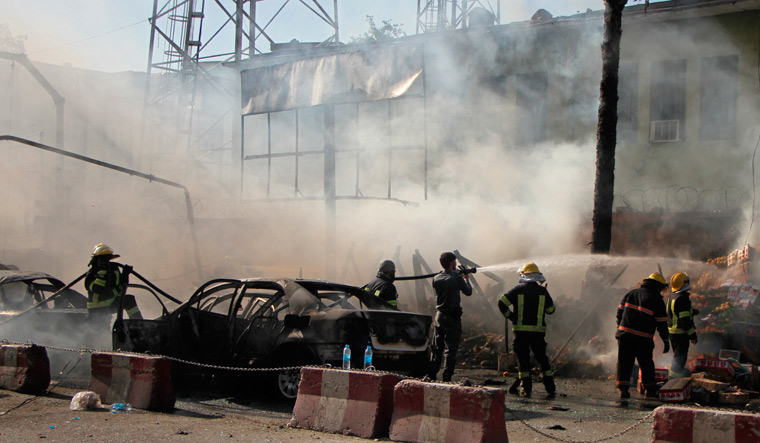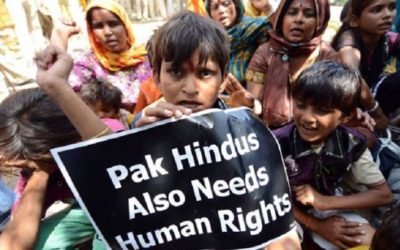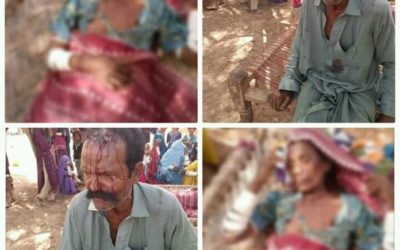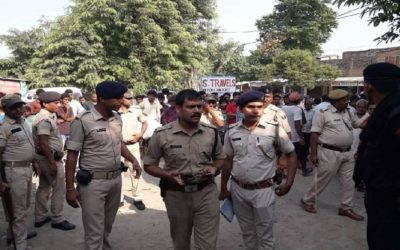Kabul city has the Koh-i-Asamai mountain, which has been a hub of worship by Afghan Hindus, Sikhs, and even followers of other faiths, Struggle for Hindu Existence has reported.
Sifra Lentin | Gateway House | Mumbai | April 9, 2020:: In the Islamic Republic of Afghanistan’s population of 36 million,[1] 300 Afghan Hindu and Sikh families[2] are the invisible minorities: the 25 March attack on Gurdwara Har Rai in Kabul’s Shor Bazaar, by the Islamic State of Iraq and the Levant (ISIL),cast the spotlight on them once again.
Local Afghans and the Afghan government condemned it as an attack on their brethren, specifically ‘Lalas’ (lit. big brothers), the term by which indigenous Afghan Sikhs and Hindus are addressed. There was an outcry when the last major attack on the Sikh community on 1 July 2018 in Jalalabad happened, their leader Avatar Singh Khalsa and other prominent Sikhs were ambushed by a suicide bomber, leaving 19 dead (including Khalsa).[3]
The solidarity shown by Afghans the world over at that time, and the subsequent condolence visit by President Ashraf Ghani to meet both communities at the historic Gurdwara Karte Parwan (Kabul), have ever since been green shoots of hope for its few remaining members. The fact that the Afghan people stood shoulder to shoulder with their minorities, has helped weaken the narrative perpetuated by religious fundamentalists that Afghan Hindus and Sikhs are Indian because their faiths[4] originate in the Indian sub-continent.
This falsehood redacts centuries of Afghan Hindu and Sikh history and their unique cultural-religious identity, forged in a rugged, landlocked South-Central Asian country. These minority communities (like the Afghan Jews and Christians) lived in relative peace till as recently as 1970s, in an Afghanistan known for its moderate Islam, religious syncretism and pluralistic culture under its Amirs.
Nearly 70 functioning gurdwaras (or dharamsaals)[5] and scores of ancient temples in the 1970s point to the significant presence of these communities. Today many are damaged or locked, or usurped, when their congregations began fleeing abroad to Canada, the United Kingdom, Germany, Pakistan and India[6] to escape the Civil War between the Communist government in Kabul and the Mujahideen. This coincided with Soviet troop withdrawals in 1989.
While retracing how Hinduism and Sikhism took root in Afghanistan, it is important to note that both predated the nation of Afghanistan as we know it today, which came into being only in 1747 when Amir Ahmed Shah Durrani (Abdali) unified the Pashtun tribes to establish an Afghan Kingdom.[7][8]
The 9th-Century Hindu Shahis
Islam as a religion became predominant in South Central Asia almost two or three centuries after its founding by the Prophet Muhammad in the 7th century. Numerous religions – Buddhism, Hinduism, Judaism, Christianity, Shamanism,[9] Animism and Islam–coexisted in this region and travelled through it along the southern branch of the Old Silk Road, which was milestoned by oasis towns such as Samarkand, Bukhara, Merv (the first two are in Uzbekistan and the last in Turkmenistan), Balkh, Kabul, Ghazni (in present-day east Afghanistan) and Herat (to its west).
A Hindu Shahi dynasty ruled Peshawar, Kabul and Gandhara, in the late 9th century, but could not withstand the onslaught of the Ghaznavids and disappeared by 1021 A.D. (Mahmud of Ghazni made the first of 10 incursions into the Indian subcontinent in 1001 A.D.)Having conquered the regions to the north of Ghazni, Mahmud’s son shifted his capital to Kabul.
Kabul city has the Koh-i-Asamai mountain, which has been a hub of worship by Afghan Hindus, Sikhs, and even followers of other faiths. The mountain is home to the Old Asamai Temple and the new one near its peak.[10] Even those who fled abroad built temples to Asamai (asha, meaning hope, and mai goddess).[11][12]
The one in Kabul is regarded to be 4,000 years old, says Sumeer Bhasin, entrepreneur and independent geopolitical analyst who has lived in Afghanistan since 2002. But he thinks tracing the history of trade between the regions offers a more reliable indication of the beginnings of Hindu presence in Afghanistan.
The Baburnama(on the life of Emperor Babur, founder of the Mughal dynasty in India), for example, refers to caravans from Hindustan and Kabul being Hindustan’s own market.[13] Emperor Akbar, grandson of Babur, who is considered the founder of Peshawar in the Pashtun heartland, was known to encourage both Hindus and Muslims to settle there.
Hindu traders, like the Multanis (from West Punjab), and (after the 18th century) the Shikarpuris (from Sindh), were astute bankers, money changers, moneylenders and traders, and were indispensable to the economy of the Central Asian Silk Road, much like the Jews in early modern Iraq.[14] Only the menfolk among the Multanis and Shikarpuris traversed these routes, never their families, thus becoming an important addition to the already resident Hindu populations in Kandahar, Ghazni, Kabul, Jalalabad, Sultanpur, Mazhar-i-Sharif, and Herat.[15]
In Guru Nanak’s footsteps
The arrival of the Afghan Sikhs roughly datesback to two events. One, the travels of Guru Nanak (1469-1539), the founder of the Sikh faith, with his companions, who, while on their way home from Mecca, Medina and Baghdad, stopped in Kabul and Kandahar, before crossing over into the Punjab via the Kurram Pass. Nanak’s travels are recorded in the much revered Janamsakhis, which do not contain any dates, but Sikh pilgrimage sites, like the Tohri Bala stream outside Kabul, are testimony to his visits. Also, his preaching of the new faith among locals resulted in many Hindus becoming his followers. In Kabul city, a prominent Hindu, Maan Chand, became a follower,and subsequently, an important preacher of Sikhism in the region.

Sikh girls and ladies at Gurdwara Karte Parwan. Notice the wood-fired heater in the foreground. Photo courtesy: Lovneet Bhatt.
Secondly, “Even during the Dardar Khalsa’s[16], and later, during Maharaja Ranjit Singh’s time there was buoyant trade with the Afghan Kingdom because the Sikh Empire came right up to Jamrud, which is now in Khyber Pakhtunkhwa Province (KPP), Pakistan. These families have been living here for 400 years or more,” says Lovneet Bhatt, a documentary filmmaker who is working on a project on Afghan Hindus and Sikhs.
Pertinent also is the fact that the Sikhs – whether Keshdharis (turbaned), Sahajdharis (shaven) or Udasis (followers of Guru Nanak’s son, Sri Chand[17] –speak a syncretic dialect, Hindko, a mix of Punjabi, Pushto, Urdu and Persian. Hindko is chiefly spoken in KPP, its cities of Peshawar and Abbottabad, and the fringes of western Punjab, which suggests that the bulk of this community, which is mostly Khatri, hails from this region.(See Part 2) [18] Like most Afghans, both Hindus and Sikhs are multilingual communities, additionally speaking both Pushto and Dari, the official languages of Afghanistan.
Their unique identity is based most visibly on language and religion, but also, that they are predominantly practitioners of Unani medicine. The few Afghan Sikhs who remain enjoy a clientele that cuts across all ethnicities within Afghan society.
Today, the two communities are no longer financially influential the way they were before the large dried fruit and cloth traders, informal bankers and moneylenders departed. Many small traders continue to run grocery and cloth shops and pharmacies, but live in the gurdwaras and temples because their properties have been illegally occupied. They face not only daily rowdyism on the streets (just like other Afghans), but religious persecution and sporadic violence as well, like last week’s attack on Gurdwara Har Rai. (They need police protection when cremating their dead.) Yet, the communities have two representatives[19] in the Afghan parliament, vindication that in spite of being almost invisible there is a good chance that their rights and historic legacy in Afghanistan will be protected.
image Source: www.theweek.in





Good day! I know this is kinda off topic but I was wondering which blog platform are you using for this site?
I’m getting sick and tired of WordPress because I’ve
had issues with hackers and I’m looking at alternatives for another platform.
I would be great if you could point me in the direction of a good platform.
excellent publish, very informative. I wonder why the opposite experts of this sector
do not realize this. You must proceed your writing. I am confident, you have a great readers’ base already!
An impressive share! I’ve just forwarded this onto a colleague
who had been doing a little homework on this.
And he in fact bought me breakfast because I discovered it for him…
lol. So let me reword this…. Thanks for the meal!!
But yeah, thanx for spending the time to talk about this matter here on your internet site.